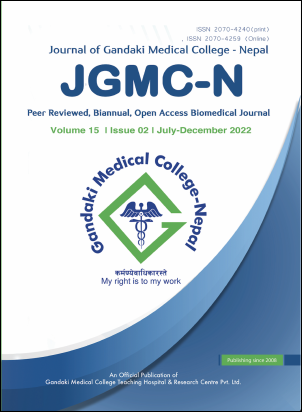Factors associated with final visual outcome in traumatic hyphema
DOI:
https://doi.org/10.3126/jgmcn.v15i2.43744Keywords:
Closed globe, hyphema, injury, visual outcomeAbstract
Introduction: Hyphema is the accumulation of blood in anterior chamber of the eye that can directly affect our vision. Various factors play role in final visual outcome among patients with hyphema, and there are very few related studies. Therefore, this study aimed to determine the factors related to final visual outcome among patients with traumatic hyphema.
Methods: This cross-sectional study was conducted among 62 cases of traumatic hyphema presenting to the emergency department of Tribhuwan University Teaching Hospital and outpatient department of Bisheshwar Prasad Koirala Lions Centre for Ophthalmic Studies from July 2018 to July 2019. A detailed clinical history was obtained, followed by an ophthalmic examination and relevant investigation. Data was analysed using descriptive and inferential statistics at 5% level of significance using IBM statistical package for the social sciences.
Results: Projectile (54.8%) and fall injury (12.5%) were the most common mode and causes of trauma, respectively. The best visual acuity of the involved eye at presentation was 6/9 (6.5%), and the worst was non-perception of light (3.2%). At presentation, the most common grade of hyphema was grade I (48.4%), and the least common was microhyphema (6.5%). Grades of hyphema (p=0.014) were significantly associated with the final visual outcome. Anterior segment findings such as of lid (p<0.001) and lens (p=0.014) and posterior segment findings such as of vitreous (p<0.001) and retina (p=0.048) were also significantly associated with final visual acuity.
Conclusions: For the most optimal visual outcome in traumatic hyphema, all associated periocular and intraocular findings must be prioritized and addressed accordingly.
Downloads
Downloads
Published
How to Cite
Issue
Section
License
Copyright (c) 2022 Bishow Raj Timalsina, Jyoti Baba Shrestha, Pragati Gautam, Kabiraj Poudel

This work is licensed under a Creative Commons Attribution-NonCommercial 4.0 International License.
This license allows reusers to distribute, remix, adapt, and build upon the material in any medium or format for noncommercial purposes only, and only so long as attribution is given to the creator.

